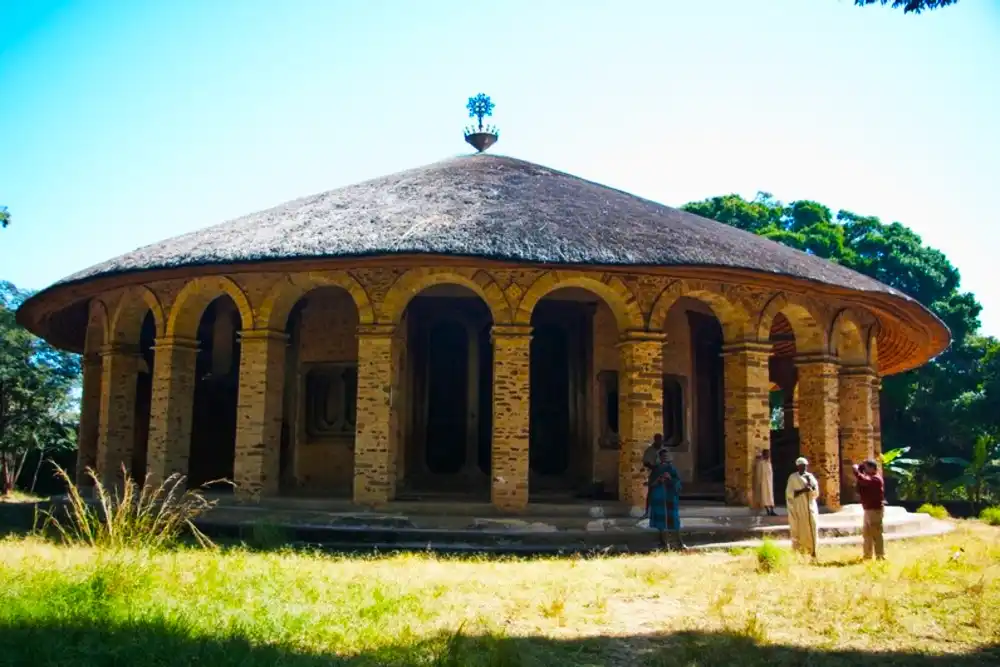Historical landmarks in Ethiopia

ROCK HEWN CHURCHES OF LALIBELA
In a country of spectacular sites, Lalibela is the undisputed jewel in the crown. Sat within a spectacular mountain-top setting, Lalibela plays host to the most incredible period in Ethiopian history, the reign of King Lalibela and his attempt to build a new Jerusalem in Ethiopia. Within the confines of the town itself, there are 11 magnificent rock-hewn churches carved out of the ground in an incredible feat of engineering in the 12th Century. Kind Lalibela’s intention was to build a new Jerusalem, so his followers wouldn’t have to take the pilgrimage to the real thing, and he made a good attempt at doing so. Whilst 11 churches is a lot for anyone to take in, the real beauty of Lalibela is in wandering round the rock carved passageways and running your hand over the ancient walls taking in a sense of the intense spirituality that flows through this place.
Outside Lalibela itself, a visit to Asheton Maryam (a precursor to the churches in town) offers a lovely steep 2 hour walk (or mule ride) to a spectacular mountain-top setting.
Lalibela stands out in Ethiopia for its more modern attitudes to tourism, the people are friendly, there is less hassle, and there is a growing portfolio of good hotels, restaurants and low key community tourism activities. It is worth spending a couple of nights to take it all in.

THE ISLAND MONASTERY OF LAKE TANA
With a relaxed air, a vast lake dotted with ancient island monasteries and several good lodge options, Bahir Dar is a great place to start or finish a trip in Ethiopia. Bahir Dar sits on the Southern shore of Lake Tana, source of the Blue Nile and the largest lake in Ethiopia.
The highlight of a visit is a boat trip out to the Island monasteries, built in the late 16th and 17th Centuries. It is believed that their isolated position was to protect from attack by Muslim invaders. There are over 30 in total, but you only need see a couple to capture the magic of the place. Ura Kidane Merit is one of the most famous and if you can handle the souvenir stalls on the 15 minute walk up to the monastery the artwork and light in the church is superb. Kebran Gabriel (17th Century) is one of the most atmospheric churches, but unfortunately only men are allowed to enter.
An hour’s drive from town (on an albeit awful road) are the Blue Nile Falls. Don’t listen to the nay-sayers who claim their majesty has been dampened by the hydro-electric scheme, the falls are still majestic and amongst the best in Africa, particularly during the rainy season (July – end of September). In the dry season, the water still flows and it is possible to do a nice boat trip and walk to the base of the falls.
Lake Tana has some comparatively superb accommodation options. The Kuriftu Spa on the shores of the Lake, is always a very welcome rest point in a busy itinerary, with the pool, spa and relaxing atmosphere a welcome contrast.
THE CASTLES OF GONDAR
Gondar is a buzzing, noisy City where muddy streets crammed with basic shacks sit cheek and jowl with modern housing estates and one of Ethiopia’s largest and best Universities.
From 1636 to the 18th Century, Gondar (also spelt Gonder) sat prominently as the rich and powerful capital of Ethiopia. Established by King Fasilades, the Royal Compound is a UNESCO World Heritage Site bringing an intriguing touch of Camelot to Africa. The intrigues, brutality and riches of court life are brought to life as you wonder through the well restored castles and palaces.
From the same period, Fasilades Baths are well worth a visit, and the church of Debra Herhan Selassie contains some of the finest religious art in Ethiopia. Incredibly vibrant and evocative images are laid out in a comic strip style depicting the stories of saints and martyrs. Highlights include a startling portrait of the devil, cowering in the flames of hell and multiple blood splattered decapitations that a Hollywood director would be proud of.
Axum Tsion
Once referred to as “Ethiopian Rome”, and the previous capital of the oldest Christian kingdom in the world, Axum is home to an ancient ruling Empire where kings were once crowned. Caravan routes met here, in Northern Ethiopia which allowed the kingdom to command the Ivory trade with Sudan and control the Red Sea trade through Port Adulis, giving the Axumite kingdom a symbol of wealth and importance for close to seven hundred years.
The magical power of sacred land and an atmosphere of peace permeates this site, drawing pilgrims and devotees to worship from near and far. Known as the Tigray region, and part of the Northern Historical Circuit, Axum is visited between the cities of Makele and Gondar- the Camelot of Africa.
What to See
The highlights of this ancient kingdom include giant obelisks, ancient castles, the Queen of Sheba’s palace and bath, King Ezana’s inscription, King Kaleb’s tomb, King Bazen’s tomb, and the Ark of the Covenant. The ruins of Axum are dominated by giant stelaes, crafted from natural stone. The tallest standing obelisk towers at 23 m, while the largest in the world lies in ruins where it fell. These obelisks are said to mark the sites of royal tombs, and are intricately carved. At the base of the collapsed obelisk, entrances to tombs have been exposed and very few of the underground grave chambers are open to visitors. Before visiting the obelisks, and the tombs that lay within them, a visit to Axum is best started at the St. Mary of Zion Church where it is rumoured to house the Ark of the Covenant, brought to Axum by the Queen of Sheba’s son. It is said, the legendary Queen of the south visited King Solomon in Jerusalem so that he might teach her the Jewish faith. She was seduced by the King and later gave birth to a boy- Solomon’s son, Menelik. After exploring the obelisks and visiting the church, make your way away from town to the Queen of Sheba’s bath, now used by locals. This is a great place to refresh yourself and take in some local everyday life. Since the area is not overrun by tourists, engagement with locals is very easy in this part of Ethiopia.
Casually housed in a small shed, and farther up a hill away from town, we make our way to King Ezana’s inscription. This is a tablet written in multiple languages, showing that people in the Axumite kingdom spoke and wrote in several languages, furthering its claim as a trading powerhouse of the ancient world. At the top of the hill away from town, sits King Kaleb’s tomb and below it, King Bazen’s Tomb- rumoured to be one of the three wise men at Jesus’ birth.
End your walk about Axum at The Palace of the Queen of Sheba. Located in the western part of Axum, the palace is across the street from the Guduit Staele field, where you explored the obelisks and tombs of ancient kings.
Getting Around
Remaining the capital of the Ethiopian Church, Axum s a clean, well kept town with cobbled streets and attractive flame trees providing shade throughout. Exquisite art is housed inside churches, hidden behind beautifully intricate tapestries. Getting around in a Bajaj, blue three wheeled motorized rickshaws, is the best way to see Axum.
What to Eat
While bombing around the sites in your Bajaj, ask your driver about tasting Ful. This spicy tomato and bean dish topped with yogurt and scrambled eggs is served with crusty bread and is a must have when visiting the area.
Visit Antica Traditional, a local spot where food and drink are flowing, while music and dance is in abundance. On the outside this may seem like a perfect spot for tourists, but you will find that locals arrive here in abundance to enjoy the food, drink, and festivities.


